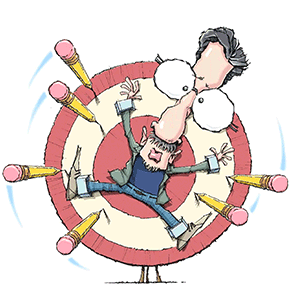Pets
/Home & Leisure
Ask the Vet: Hoarder Has Too Many Animals for Adequate Care
Q: My neighbor has more cats than I can count, so I assume she's a hoarder. Should I intervene? If so, how?
A: Just having many cats doesn't make your neighbor a hoarder. What would make her a hoarder is having more cats than she can properly care for.
Hoarders fail to provide even minimal standards of shelter, sanitation, nutrition or ...Read more
Ask the Vet: Medications Can Diminish Dog's Sense of Smell
Q: I'm training my dog Roger for search and rescue, which requires him to use his nose. I noticed while I was taking a particular medication that my sense of smell worsened. Can the same thing happen to dogs? If so, what drugs affect their sense of smell?
A: A dog's nose has more than 300 million olfactory receptors that detect scent, while ...Read more
Ask the Vet: Three Reasons Not to Toilet Train Your Cat
Q: I'm thinking about teaching Cameo, my newly adopted young calico cat, to use the toilet instead of a litter box. Are most people successful at toilet training their cats?
A: I don't recommend toilet training cats for three reasons.
First, my mom told me that when she visited her aunt, who had toilet trained her cat, the toilet seat was ...Read more
Ask the Vet: Sterilized Dogs Live Longer
Q: Should we neuter Max, our 3-year-old Jack Russell terrier? Our veterinarian described the behavioral benefits of neutering, but those are not an issue for us. Max is healthy and lots of fun, and we just want him to live forever.
A: Keeping Max around as long as possible is a good enough reason to have your veterinarian neuter him, because ...Read more
Ask the Vet: Celebrate Easter With Chocolate Bunny, Not Live One
Q: I'm thinking of surprising my 6-year-old niece with a rabbit on Easter. The pet store sells bunnies of various sizes and ear styles. Is one type of rabbit healthier or friendlier than the others?
A: My first pet joined our family when I was younger than your niece, and I got my first rabbit at about your niece's age, but I don't recommend ...Read more
Ask the Vet: Flat-Faced Breeds Prone to Health Problems
Q: My dog Hugo is the cutest, most lovable French bulldog I know. When I submitted a photo of him to a calendar contest, they refused to accept it because he is a brachycephalic dog, and they consider it inhumane to promote unhealthy dogs. I hope you can explain their discriminatory position, because I am mystified.
A: Brachycephalic dogs have ...Read more
Ask the Vet: Toxic Mushrooms Resemble Harmless Varieties
Q: We've had a lot of rain this year, and our yard is filled with a variety of mushrooms. How can we identify those that could poison our dogs, and how will we know if our dogs ate them?
A: Animal poison control specialists are receiving twice as many calls about mushroom poisoning this year as last. That's frightening because toxic mushrooms ...Read more
Ask the Vet: Nerve Damage Causes Horner's Syndrome
Q: Hobie, my middle-aged indoor-outdoor cat, awoke this morning with one very abnormal eye. His upper lid droops, and a white film covers the inside corner of the eye. What caused this? Will it resolve on its own, or should I take Hobie to his veterinarian?
A: I'd advise a trip to the vet. It sounds like Hobie has Horner's syndrome, which is ...Read more
Ask the Vet: Keep Bread Dough Away From Dog
Q: I'm doing a lot of extra baking these days since the pandemic keeps me at home more. My family loves my fresh bread, but making it gave rise to a near-catastrophe involving our dog, Bandit.
When my back was turned, Bandit stole some freshly made bread dough right off the kitchen counter. I didn't realize it was a problem until he started ...Read more
Ask the Vet: Fleas Transmit Plague Bacteria
Q: I caught the end of a news report about pets and the plague. I thought the plague was eradicated ages ago, at least from the U.S. Do I need to worry about my indoor-outdoor cats getting infected? Is this the next pandemic?
A: The deadliest pandemic in history was caused by the plague in the mid-1300s. While I doubt that will be repeated, the...Read more
Ask the Vet: Dog's Cold, Wet Nose Doesn't Guarantee Good Health
Q: I'm confused about why my dog Sam's nose is occasionally warm and dry, even though he seems fine. I thought a dog in good health always had a cold, wet nose.
A: Sam's nose is usually cold and wet for two reasons.
First, nasal glands inside his nose produce a watery liquid that cools and dampens the lining of his nasal passages and the ...Read more
Ask the Vet: Even Indoor Cats Need Rabies Vaccination
Q: My cat BarB -- so named because I found her as a kitten hiding under my barbecue grill -- now lives in my house and doesn't venture outdoors. Her veterinarian insists she needs rabies vaccination. Why is this necessary, if she's a committed homebody?
A: BarB should be vaccinated for rabies to protect herself and you from the deadly disease. ...Read more
Ask the Vet: Thank Veterinarian for Great Care
Q: Our veterinarian has always been wonderful with our cats, so we want to give her a gift on Valentine's Day. Chocolate seems wrong since it's toxic to pets. Do you have better suggestions?
A: What a lovely thought! I'm sure your veterinarian will enjoy whatever gift you choose.
My first suggestions recognize that everyone at the practice has...Read more






